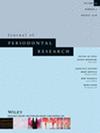Effects of oxidized LDL versus IL-1ß/TNF-ɑ/INFɣ on human gingival mesenchymal stem cells properties
Abstract
Aims
Oxidized low-density lipoprotein (oxLDL) is an important player in the course of metabolic inflammatory diseases. oxLDL was identified in the gingival crevicular fluid, denoting possible associations between oxLDL-induced inflammation and periodontal disease. The current investigation compared for the first-time direct effects of oxLDL to a cytokine cocktail of IL-1ß/TNF-ɑ/INF-γ on gingival mesenchymal stem cells' (G-MSCs) attributes.
Methods
Human third passage G-MSCs, isolated from connective tissue biopsies (n = 5) and characterized, were stimulated in three groups over 7 days: control group, cytokine group (IL-1β[1 ng/mL], TNF-α[10 ng/mL], IFN-γ[100 ng/mL]), or oxLDL group (oxLDL [50 μg/mL]). Next Generation Sequencing and KEGG pathway enrichment analysis, stemness gene expression (NANOG/SOX2/OCT4A), cellular proliferation, colony-formation, multilinear potential, and altered intracellular pathways were investigated via histochemistry, next-generation sequencing, and RT-qPCR.
Results
G-MSCs exhibited all mesenchymal stem cells' characteristics. oxLDL group and cytokine group displayed no disparities in their stemness markers (p > .05). Next-generation-sequencing revealed altered expression of the TXNIP gene in response to oxLDL treatment compared with controls (p = .04). Following an initial boosting for up to 5 days by inflammatory stimuli, over 14 day, cellular counts [median count ×10−5 (Q25/Q75)] were utmost in control – [2.6607 (2.0804/4.5357)], followed by cytokine – [0.0433 (0.0026/1.4215)] and significantly lowered in the oxLDL group [0.0274 (0.0023/0.7290); p = .0047]. Osteogenic differentiation [median relative Ca2+ content(Q25/Q75)] was significantly lower in cytokine – [0.0066 (0.0052/0.0105)] compared to oxLDL – [0.0144 (0.0108/0.0216)] (p = .0133), with no differences notable for chondrogenic and adipogenic differentiation (p > .05).
Conclusions
Within the current investigation's limitations, in contrast to cytokine-mediated inflammation, G-MSCs appear to be minimally responsive to oxLDL-mediated metabolic inflammation, with little negative effect on their differentiation attributes and significantly reduced cellular proliferation.


 求助内容:
求助内容: 应助结果提醒方式:
应助结果提醒方式:


